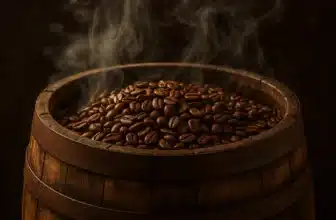
OneHundredCoffee is reader-supported, and some products displayed may earn us an affiliate commission. Details
Coffee lovers know that a grinder is one of the most important tools for achieving a perfect cup. Yet, one of the most debated topics in coffee preparation remains blade grinders versus burr grinders. Each type significantly influences your coffee’s flavor, aroma, and overall quality. This guide delves deep into the differences between blade and burr grinders, exploring their impacts on your brewing outcomes.
How Blade Grinders Work
Blade grinders function similarly to small blenders, equipped with a rapidly spinning blade that chops coffee beans into smaller pieces. They’re simple, inexpensive, and widely available. The grinding process is quick and intuitive: the longer you grind, the finer your coffee grounds become. However, this straightforward approach has notable drawbacks, particularly related to consistency.

Compact and affordable grinder with stainless steel blades. Great for quick, fresh grinds at home or work.
Price on Amazon
Reliable blade grinder with removable chamber. Easy to clean and consistent for daily grind size control.
Price on Amazon
Classic design with stainless steel bowl and fast blade action. Compact and ideal for morning coffee prep.
Price on Amazon
Sleek and simple grinder with durable blades. One-touch operation for fast, efficient grinding of beans or spices.
Price on AmazonHow Burr Grinders Work
Burr grinders utilize two abrasive surfaces (burrs) to crush beans into uniform particles. Beans pass through these burrs at adjustable distances, allowing precise control over grind size. Burr grinders come in two main types: flat burr grinders, featuring two flat, ring-shaped burrs, and conical burr grinders, where one burr is cone-shaped. Burr grinders are renowned for their consistency and precision.

Precise conical burrs, 38 grind settings, and a mess-free hopper make this a reliable grinder for daily coffee lovers.
Price on Amazon
Large capacity grinder with 18 grind levels. Easy to clean and consistent grind for French press to espresso.
Price on Amazon
Portable stainless steel manual grinder with ceramic burrs and 18 grind settings. Perfect for travel and home brewing.
Price on Amazon
Premium manual grinder with ceramic burrs, precision adjuster, and minimalist design. Great for pour-over or cold brew fans.
Price on AmazonConsistency: The Major Difference
Consistency in grind size dramatically impacts extraction quality, flavor, and aroma in coffee brewing. Blade grinders struggle significantly here, producing uneven particles—some coarse, some extremely fine. This unevenness leads to uneven extraction, resulting in coffee that’s simultaneously bitter and sour. Conversely, burr grinders excel at delivering uniform particle sizes, enhancing balanced extraction and consistent flavor.
| Attribute | Blade Grinder | Burr Grinder |
|---|---|---|
| Grind Consistency | Uneven | Highly consistent |
| Extraction | Unbalanced | Even, balanced |
Impact on Flavor and Aroma
Uneven grounds from blade grinders negatively impact flavor, causing some grounds to over-extract (creating bitterness) and others to under-extract (yielding sourness). This inconsistency masks the coffee’s true flavor potential. Burr grinders, by contrast, achieve uniform grounds that optimize extraction, preserving nuanced aromas and flavors, whether bright fruity notes or deep chocolate undertones.
Heat Generation and Its Effect
Blade grinders generate considerable frictional heat due to high-speed spinning blades, potentially altering coffee flavor by causing the premature release of aromatic oils. Burr grinders generate significantly less heat, ensuring aromatic compounds and oils remain preserved, resulting in fresher-tasting coffee. This factor greatly contributes to burr grinders’ superiority in professional and home coffee brewing.
Grind Size Control and Brewing Versatility
Blade grinders offer minimal control over grind size, mainly relying on timing to achieve finer or coarser grounds, often leading to unpredictable results. Burr grinders feature adjustable settings for precise grind size control, allowing users to tailor their grind to specific brewing methods—from espresso and AeroPress to pour-over and French press—maximizing each brew method’s potential.
| Feature | Blade Grinder | Burr Grinder |
|---|---|---|
| Size Control | Limited | Precise, adjustable |
| Brewing Methods | Limited versatility | High versatility |
Efficiency and Waste
Blade grinders frequently produce fine dust and coarse chunks simultaneously, increasing waste and requiring more coffee beans to achieve the desired flavor. Burr grinders maximize bean usage efficiency, yielding uniformly sized grounds with minimal waste. Over time, this efficiency translates into substantial savings, despite burr grinders’ higher upfront costs.
Noise and Operation
Blade grinders, operating at high RPMs, tend to be noisier, often disrupting quiet mornings. Burr grinders typically run quieter due to their slower, more controlled grinding mechanism. This subtle yet noticeable difference enhances user experience, especially for early risers or households sensitive to noise.
Longevity and Durability
Blade grinders, typically built with less durable components, are prone to quicker wear and shorter lifespans. Burr grinders, designed with robust, precision-engineered parts, usually offer superior longevity, making them a better long-term investment. Their replaceable burr sets further extend their usability, solidifying their role as a cost-effective choice despite a higher initial investment.
Cost Considerations
Blade grinders appeal primarily due to affordability, commonly priced between $15 and $30. However, the lower cost comes with drawbacks like inconsistency and shorter lifespan. Burr grinders range broadly from $50 to several hundred dollars, depending on material and precision, but they consistently deliver superior brewing results and durability, justifying their higher price.
| Cost Factor | Blade Grinder | Burr Grinder |
|---|---|---|
| Initial Cost | Low ($15–$30) | Medium to High ($50–$300+) |
| Long-Term Value | Lower | Higher (durability, efficiency) |
Making Your Decision
Your choice ultimately hinges on your brewing preferences, budget, and commitment to coffee quality. If affordability and convenience outweigh precision, a blade grinder might suffice, particularly for casual coffee drinkers. However, if optimal flavor, consistency, and versatility matter deeply, investing in a burr grinder will significantly elevate your brewing experience, ensuring every cup reaches its full potential.






